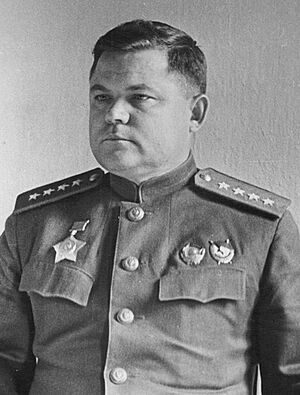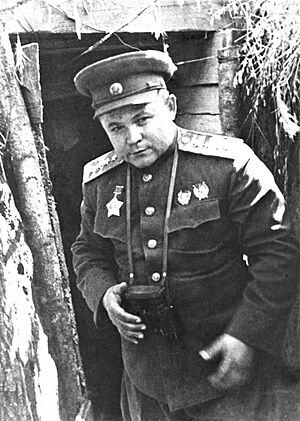Nikolai Vatutin facts for kids
Quick facts for kids
Nikolai Vatutin
|
|
|---|---|

Vatutin c. 1940s
|
|
| Native name |
Николай Фёдорович Ватутин
|
| Nickname(s) | Grandmaster General Offensive |
| Born | 16 December 1901 Chepukhino, Voronezh Governorate, Russian Empire (now in Belgorod Oblast, Russia) |
| Died | 15 April 1944 (aged 42) Kiev, Ukrainian SSR, Soviet Union |
| Allegiance | |
| Years of service | 1920–1944 |
| Rank | Army General |
| Commands held |
|
| Battles/wars |
|
| Awards | Hero of the Soviet Union Order of Lenin (2) |
| Children | Elena (1930–?) Viktor (1932–?) |
| Relations | Tatiana Romanovna Vatutina (wife) Jelena (daughter, 1930–2016) Viktor (son, 1932–?) |
| Signature |  |
Nikolai Fyodorovich Vatutin (Russian: Николай Фёдорович Ватутин; 16 December 1901 – 15 April 1944) was a important Soviet military leader during World War II. He was known for leading many Red Army operations in the Ukrainian SSR. He commanded the Southwestern Front and the Voronezh Front during the famous Battle of Kursk. Later, Vatutin led the 1st Ukrainian Front during the Soviet push to take back parts of Ukraine. His forces were key in the attacks west and southwest of Kiev, which led to the city's liberation.
In February 1944, he was attacked and badly wounded by Ukrainian Insurgent Army fighters. He died from his injuries a few weeks later.
Contents
Early Life and Military Start
Nikolai Vatutin was born on December 16, 1901, in the village of Chepukhino. This village was in the Voronezh area of the Russian Empire. His family were farmers, and he was of Russian background.
Joining the Red Army
Vatutin joined the Red Army in 1920. He fought against peasant groups led by Nestor Makhno. The next year, he became a member of the Russian Communist Party (Bolsheviks). He worked hard in his early command roles.
From 1926, he spent ten years studying at important military schools. These included the Frunze Military Academy and the General Staff Academy. In 1937–1938, many Red Army leaders were removed during the "Great Purge." This event helped Vatutin get promoted. In 1938, he became a Komdiv (a military rank). He was made Chief of Staff for the important Kiev Military District. During this time, Vatutin also took part in many party activities.
Pre-War Planning
In 1939, Vatutin helped plan the Soviet invasion of Poland. This happened at the same time as the German invasion. He was Chief of Staff for the Red Army's Southern Group. In 1940, this group, led by Georgy Zhukov, took Bessarabia from Romania. For his work in these campaigns, Joseph Stalin promoted him to lieutenant general. He was also given the important job of Chief of the Operational Directorate of the General Staff.
However, Vatutin was not fully ready for this new role. He was creative and worked hard, but he had little experience in actual combat. His knowledge of war strategy was mostly from books. Still, because he came from a farming family, was relatively young, and was very loyal to the party, he was one of Stalin's favorites. Vatutin and other Red Army leaders did not fully prepare the army for the German attack on June 22, 1941.
On June 30, 1941, he became Chief of Staff of the North-Western Front. This role allowed him to use his strengths better. Vatutin did not try to take credit for victories. Instead, he focused on finding and promoting talented officers under him. He was known for being bold. Many Soviet generals were afraid to attack after early defeats. But Vatutin liked to go on the offensive.
Key Battles in World War II
Defending Leningrad
The Northwestern Front was defending Leningrad from the German Army Group North. This German force was led by Erich von Manstein. Vatutin took command of Soviet troops near Novgorod. He prepared them for an attack and tried to surround a large German force. He surprised Manstein and forced the entire German Army Group North to move its troops to stop the Soviet attack.
This slowed down the Wehrmacht (German army) and gave the Red Army more time to strengthen Leningrad's defenses. The Germans failed to capture Leningrad, which was a major mistake for them early in the war. Vatutin's immediate results were not perfect. He sometimes expected too much from his troops and planned very ambitious goals. His coordination of forces and control during battles were not always good. Also, he did not always consider the difficult land, which helped the German defenses. His army suffered many losses.
One bright spot was the skill of Ivan Chernyakhovsky, a young colonel. Both Vatutin and Chernyakhovsky liked new ways of fighting. They soon became close friends.
Demyansk Pocket
In January 1942, during the Soviet winter attack after the Battle of Moscow, Vatutin's forces trapped two German groups in Demyansk. This was the first time the Soviets had surrounded a large German force. Both armies were about the same size. Vatutin used new tactics, but the Germans fought in a more traditional way. The Red Army could not destroy the German defenses, mainly because the Soviet Air Force was not strong enough.
In April 1942, Vatutin finally broke through the German lines. However, some experts later said the battle was a draw. The Germans learned the wrong lesson from their escape. They thought they could survive being surrounded by getting supplies from the air. This idea later led to their disaster at the Battle of Stalingrad. The Soviet Air Force became much better at stopping German air supplies.
Voronezh and Stalingrad
From May to July 1942, Vatutin worked briefly as a deputy to the Chief of the General Staff. Then, the German Army Group South began a huge attack called Operation Blau. At first, the Germans focused on Voronezh. They wanted to break through the Soviet lines there and then attack the Soviet Southern and Southwestern Fronts from behind. On July 1, 1942, Stalin sent Vatutin to the important Bryansk Front. Within days, it was renamed the Voronezh Front and Vatutin took command.
During the battle, Vatutin again met Chernyakhovsky, who was now leading the 18th Tank Corps. The German attack was about to break through the Soviet lines. Chernyakhovsky's corps arrived by train. He quickly unloaded one of his brigades and attacked the Germans without waiting for the rest of his troops. He pushed them back. After this, Vatutin asked Stalin to give Chernyakhovsky command of the 60th army. Stalin was unsure about appointing such a young general. But Vatutin convinced him, and Chernyakhovsky quickly became a major Red Army commander.
Even though the Germans captured Voronezh city, they failed to break through Vatutin's main front line. The Germans then changed their plan and focused on Stalingrad. On October 22, 1942, Vatutin took command of the new Southwestern Front. He played a key role in planning the Soviet counter-attack that surrounded the German 6th Army in the Battle of Stalingrad. In December 1942, Vatutin's forces surrounded and destroyed two-thirds of the 130,000-strong Italian 8th Army. This was part of an operation called "Little Saturn." This victory helped defeat Manstein's "Winter Storm" operation, which was trying to rescue the German 6th Army.
Kharkov and Kursk
In January 1943, Vatutin's Southwest Front pushed the Germans out of Eastern Ukraine. His actions helped the Voronezh Front, led by General Filipp Golikov, capture Kharkov. However, Vatutin had pushed his tired troops too far and did not pay enough attention to the changing war situation. In February 1943, Manstein used forces from the Caucasus to surprise and defeat Vatutin south of Kharkov. This led to Golikov's troops being surrounded in Kharkov and the city being recaptured by the Germans in the Third Battle of Kharkov. Golikov was removed from his command. But Stalin did not see Vatutin's setback as a big problem. Stalin even promoted Vatutin to the rank of Army General because of his daring approach.
On March 28, 1943, Vatutin took command of the Voronezh Front again. This front was preparing for the huge Battle of Kursk. At Kursk, he did not use the usual way of lining up armies. His new plan allowed him to defend skillfully against the stronger German forces. It also let him quickly switch from defense to attack. After the Soviet victory at Kursk, Belgorod was taken back.
Retaking Kiev and Korsun-Cherkassy
After the Soviet victory at Kursk, Vatutin wanted to retake Kiev. He reorganized his forces and surprised Manstein. He moved tank forces through swampy land, scattering the Germans from an unexpected direction. On November 6, 1943, Kiev was retaken. Vatutin kept pushing after his victory in Kiev. He went deep into German defenses and broke their defensive line.
However, Vatutin stretched his armies too thin. Manstein used his reserve forces to counterattack. At the Battle of Radomyshl (November 6–15, 1943) and the Battle of the Meleni Pocket (December 16–23, 1943), Manstein launched successful counter-attacks. These attacks took back land and caused heavy losses for the Red Army.
In winter, Vatutin's front and the 2nd Ukrainian Front, led by Army General Ivan Konev, surrounded the Korsun area in January. This happened during the Korsun–Shevchenkovsky Offensive. Vatutin started his part of the operation two days after Konev. Vatutin achieved surprise by sending his tanks into battle right away and attacking from unexpected terrain. This allowed the 6th Tank Army to go deep into German defenses. On February 3, it met with Konev's advancing tanks, trapping 56,000 German troops. By February 17, Vatutin and Konev's forces had destroyed the Korsun-Cherkassy Pocket. However, many of the surrounded German troops managed to escape.
Death
On February 28, 1944, Vatutin was moving his troops for a new operation. He was heading to Slavuta when he was ambushed by Ukrainian Insurgent Army (UPA) fighters. This happened far behind the front lines near the village of Myliatyn. He died from an infection (sepsis) caused by his injuries six weeks later in a hospital in Kiev. Vatutin's brothers, Afanasy and Semyon, were also killed in action in February and March 1944. Their mother, Vera, buried her three sons within two months.
Nikolai Vatutin was given a state funeral in Kiev. Georgy Zhukov took over his command.
Vatutin was buried in Kiev's Mariinskyi Park. A monument dedicated to him was put up at his burial site in 1948. This monument was designed by the famous Soviet sculptor Yevgeny Vuchetich. On February 9, 2023, the monument was taken down by the Kyiv City State Administration. In June 2017, a street in Kiev named after General Vatutin was renamed to Roman Shukhevych Avenue. During the war, Shukhevych fought against Soviet forces. He later became a military leader of the UPA.
Legacy
Vatutin's ideas about Red Army strategy and tactics continued to be important even after his death. After the Cold War, experts began to see Vatutin as one of World War II's most creative commanders. He was praised for his ability to stop powerful German attacks and then switch to counter-offensives. He surprised and outmaneuvered German generals in several key battles. He also showed great flexibility during the Korsun offensive, using opportunities quickly to surround German forces.
In November 2014, the Ukrainian Institute of National Memory listed Vatutin as a person involved in actions against Ukraine's independence. This included organizing famines and political repressions.
On February 9, 2023, the monument to Vatutin on his grave in Kyiv's Mariinskyi Park was removed. It was moved to the local Aviation Museum. Also in February 2023, the village of Vatutine in northeastern Ukraine was set to be renamed Zaluzhne, after Ukrainian general Valerii Zaluzhnyi. On November 11, 2023, the Cabinet of Ministers of Ukraine removed the status of a monument from Vatutin's grave. This was done to follow 2023 derussification-laws.
In April 2023, the Poltava City Council also voted to remove the monument to Vatutin in that city.



